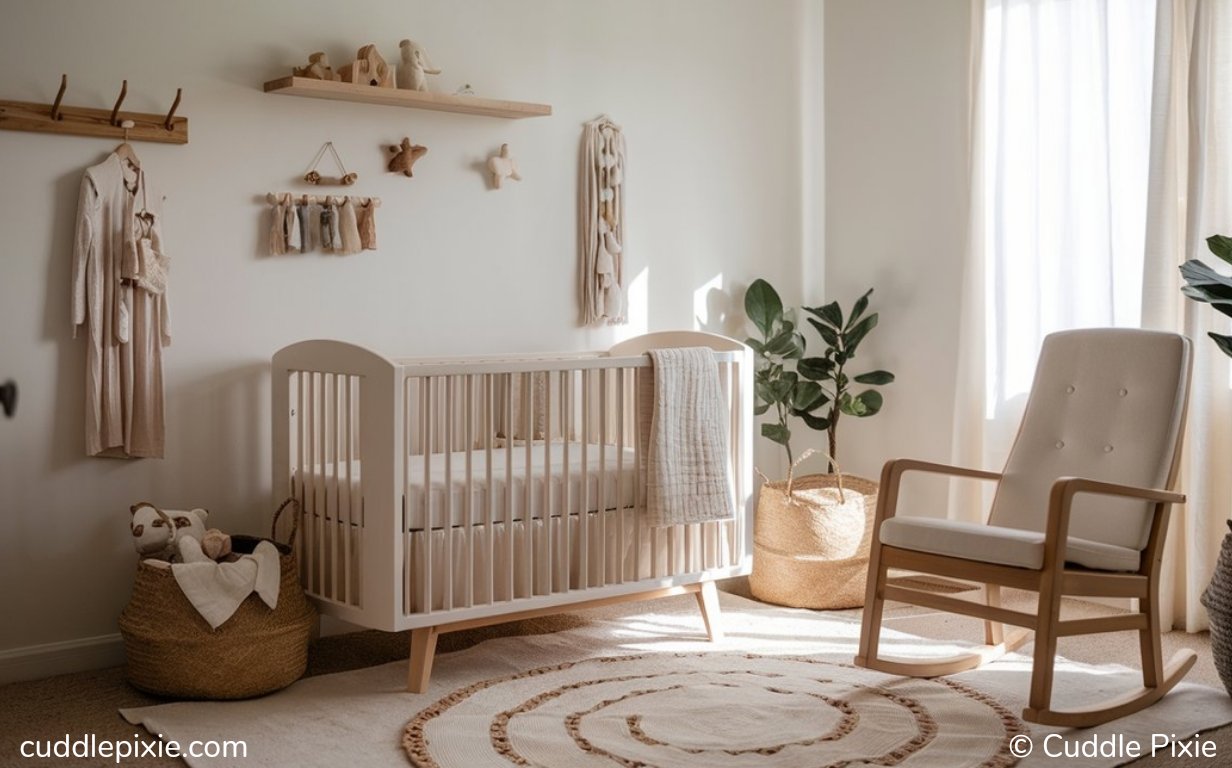Designing a nursery is one of the most exciting parts of preparing for your baby’s arrival. But with so many products and trends competing for your attention, it’s easy to get overwhelmed. Enter minimalist nursery design a trend that’s growing rapidly as parents seek a simpler, more mindful approach to decorating their baby’s room.
Minimalism is about more than just aesthetics. It’s a philosophy that promotes simplicity, functionality, and intentionality—values that align perfectly with the needs of both babies and parents. In this guide, we’ll explore how to create a minimalist nursery that’s not only beautiful but also practical and eco-friendly.
In This Article
Why Choose a Minimalist Nursery?
Minimalist nursery design goes beyond looking sleek and tidy. It has real, tangible benefits for both parents and babies.
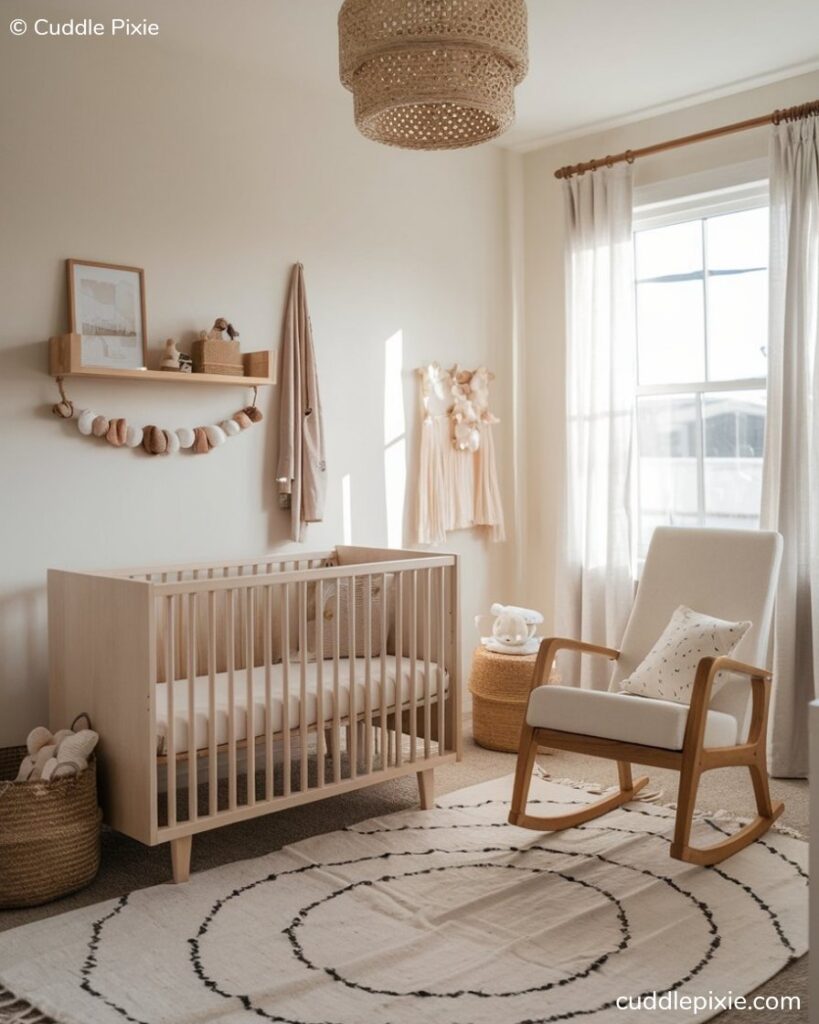
1. Less Clutter, More Calm
Minimalist nurseries are designed to reduce visual clutter. Instead of filling the room with every baby product on the market, you carefully select a few high-quality, essential items. This creates a more serene, stress-free environment—a welcome relief for new parents dealing with sleepless nights and hectic schedules.
According to Dr. Sherrie Bourg Carter, a psychologist and author, clutter can increase feelings of stress and anxiety. By keeping your nursery simple and organized, you can foster a sense of calm for both you and your baby.
2. Easier to Clean and Maintain
A minimalist nursery is not just about aesthetics; it’s also incredibly practical. With fewer items to dust and organize, cleaning becomes much more manageable. This is especially important when you’re juggling the demands of a newborn. Maintaining a clean space also helps create a healthier environment for your baby, reducing the risk of allergens.
3. A Peaceful Sleep Environment
Babies thrive in calm environments. Bright colors and busy patterns can be overstimulating, while minimalist spaces with neutral tones and simple designs create a more peaceful atmosphere. According to a study by the National Sleep Foundation, a quiet, soothing room can help improve a baby’s sleep quality.
4. Eco-Friendly Choices
Many parents today are looking for ways to make more sustainable, eco-friendly choices when designing their baby’s nursery. A minimalist nursery naturally leans into this trend by encouraging quality over quantity and focusing on natural, sustainable materials. From organic cotton bedding to sustainably sourced wood furniture, there are plenty of options for creating an eco-friendly nursery.
Key Elements of a Minimalist Nursery Design
Creating a minimalist nursery requires more than just reducing clutter. Here are the essential elements to consider when designing a minimalist space for your baby.

1. Neutral Color Palette
One of the hallmarks of minimalist design is a neutral color palette. Think soft whites, grays, beiges, and other earthy tones. These colors create a calm and soothing environment, perfect for a baby’s nursery. They also provide a timeless backdrop that you can easily update with different accents as your child grows.
However, minimalist doesn’t mean boring. You can add warmth and personality to the room with natural textures like wood, linen, and cotton. Consider incorporating a few accent pieces in muted tones—like soft blues or blush pinks—to add a subtle pop of color.
2. Functional Furniture
Minimalist design prioritizes functionality, which is especially important in a nursery. Multi-functional furniture is a great way to maximize space and keep the room uncluttered.
- Convertible Cribs: These cribs grow with your baby, transforming into toddler beds or daybeds. Look for designs made from sustainable materials like FSC-certified wood.
- Dressers that Double as Changing Tables: Instead of purchasing a separate changing table, consider a dresser that can serve both functions. Once your baby outgrows diapers, you’ll still have a functional piece of furniture for storing clothes and toys.
- Rocking Chairs: Opt for a sleek, modern rocking chair that provides comfort without taking up too much space. Pair it with a small, simple side table for nighttime feedings.
3. Quality Over Quantity
In a minimalist nursery, it’s important to focus on quality over quantity. Rather than filling the room with numerous toys and accessories, invest in a few high-quality, durable items. This not only saves space but also reduces waste and contributes to a more sustainable lifestyle.
- Choose natural, non-toxic materials like organic cotton, bamboo, and wool for bedding, blankets, and rugs.
- Look for handcrafted toys made from wood or other eco-friendly materials instead of mass-produced plastic items.
4. Declutter and Organize
Organization is key to maintaining a minimalist nursery. Use smart storage solutions to keep the room tidy and clutter-free.
- Baskets and Bins: Woven baskets or fabric bins are perfect for storing toys, books, and extra blankets. They’re functional yet stylish and can be easily tucked away when not in use.
- Floating Shelves: Floating shelves offer a simple way to display books, toys, or decorative items without taking up valuable floor space.
- Built-In Storage: If possible, incorporate built-in storage solutions like cabinets or under-crib drawers to keep the room neat and organized.
Sustainable Materials for a Minimalist Baby Room
Sustainability and minimalism go hand in hand. When designing a minimalist nursery, it’s important to choose materials that are not only stylish but also eco-friendly.

1. Organic Fabrics
Babies spend a lot of time sleeping, so it’s important to choose bedding and sleepwear made from natural, organic materials. Organic cotton, bamboo, and linen are all excellent options for crib sheets, blankets, and swaddles.
Look for products that are GOTS-certified (Global Organic Textile Standard), which ensures that the fabric is free from harmful chemicals and produced in an environmentally and socially responsible manner.
2. Natural Furniture
When selecting furniture for your baby’s nursery, choose pieces made from sustainably sourced wood. Look for brands that use FSC-certified (Forest Stewardship Council) wood, which ensures that the materials are harvested from responsibly managed forests.
Non-toxic finishes and water-based paints are also important considerations, as they help reduce your baby’s exposure to harmful chemicals.
3. Non-Toxic Paints
Many conventional paints contain volatile organic compounds (VOCs), which can release harmful fumes into the air. To create a safe and healthy environment for your baby, choose low-VOC or VOC-free paints for the nursery walls. These paints are better for both the environment and your baby’s health.
Brands like Benjamin Moore and Sherwin-Williams offer eco-friendly paint options in a wide range of colors.
Minimalist Nursery Layout Ideas
The layout of your minimalist nursery plays a crucial role in creating a functional and comfortable space. Here are a few tips to maximize space and keep the room uncluttered.
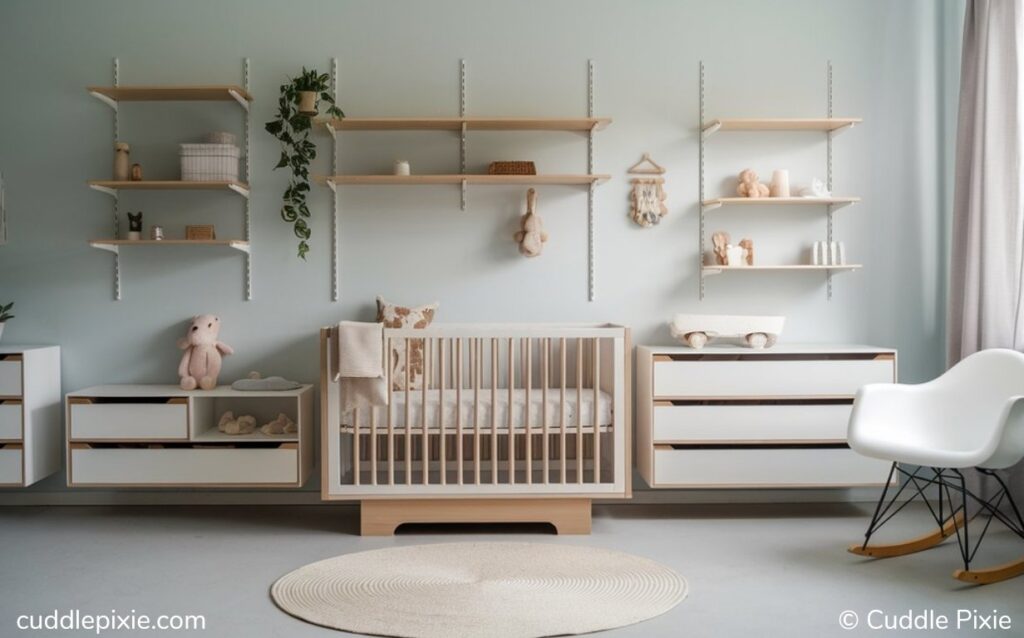
1. Maximize Space with Smart Storage
In a minimalist nursery, it’s important to make the most of every inch of space. Utilize under-crib storage, wall-mounted shelves, and multifunctional furniture to keep the room organized.
2. Focus on the Essentials
Minimalism is all about paring down to the essentials. When designing your nursery, focus on the items your baby truly needs: a crib, a changing table, a comfortable chair for feeding, and some storage for clothes and toys. Anything beyond that is just extra.
3. Keep the Floor Clear
A clutter-free floor makes the room feel more spacious and calm. Use wall-mounted shelves for books and toys instead of bulky cabinets or storage units that take up floor space.
Design Inspirations for a Minimalist Nursery
Ready to start designing your minimalist nursery? Here are a few popular minimalist nursery design styles to inspire you.
1. Scandinavian Minimalism
Scandinavian design is all about simplicity, functionality, and natural materials. Think light wood furniture, neutral colors, and cozy textures like wool and cotton. This style is perfect for creating a warm, inviting nursery that feels modern and timeless.
2. Modern Zen
If you’re looking to create a peaceful, calming space for your baby, consider a Zen-inspired minimalist nursery. This style emphasizes balance and harmony, with a focus on natural materials, clean lines, and neutral colors.
3. Rustic Minimalism
For a more earthy, organic feel, consider a rustic minimalist nursery. This style incorporates warm wood tones, handmade accents, and vintage-inspired furniture. It’s a great way to add character to the room while still keeping things simple and uncluttered.
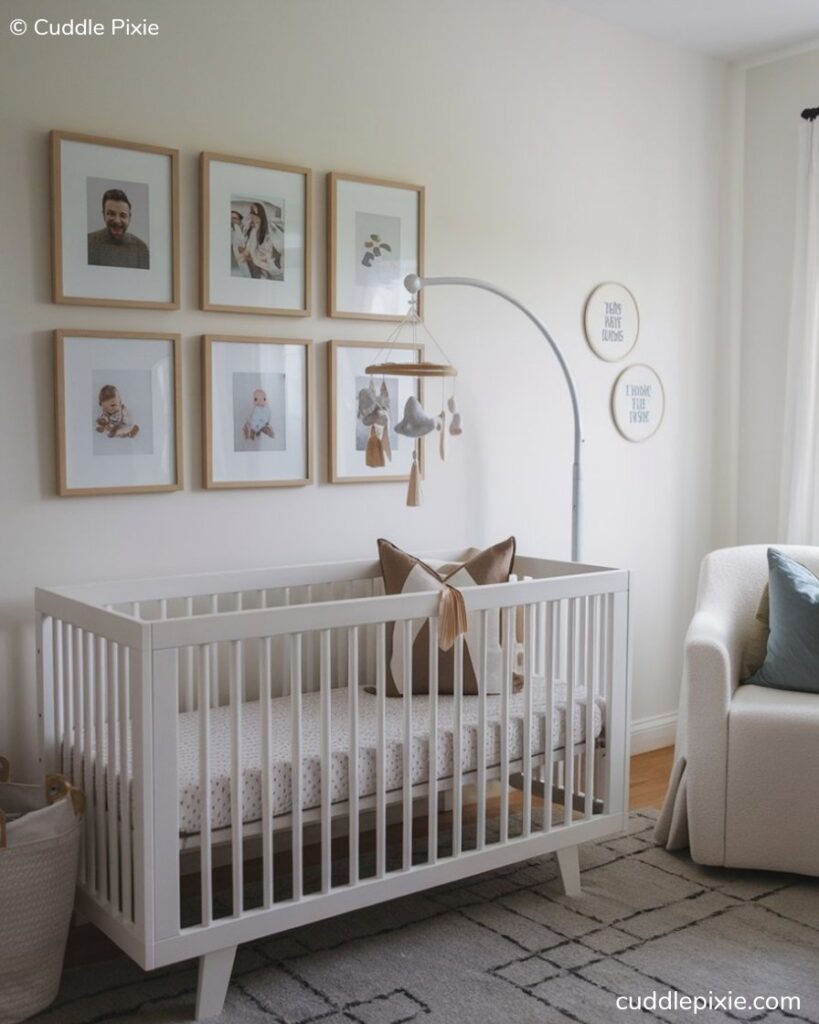
How to Personalize a Minimalist Nursery Without Overwhelming It
One common misconception about minimalist design is that it lacks personality. In reality, a minimalist nursery can be just as warm and personal as any other style. Here are a few tips for adding your own unique touches without overwhelming the space.
1. Custom Art and Photos
Personalize the nursery with custom artwork or family photos. Keep it simple by choosing a few meaningful pieces and displaying them in sleek, modern frames. You can also create a gallery wall with a mix of framed prints, paintings, and photographs to add visual interest without clutter.
2. Handcrafted Items
Incorporate handmade or heirloom items into the nursery to add a personal touch. A knitted blanket from a family member, a handmade mobile, or a vintage toy can all bring warmth and character to the room.
3. Pops of Color
While a neutral color palette is a key element of minimalist design, that doesn’t mean you have to avoid color entirely. Add small pops of color through accents like throw pillows, blankets, or wall art. Just be sure to keep the overall color scheme soft and cohesive.
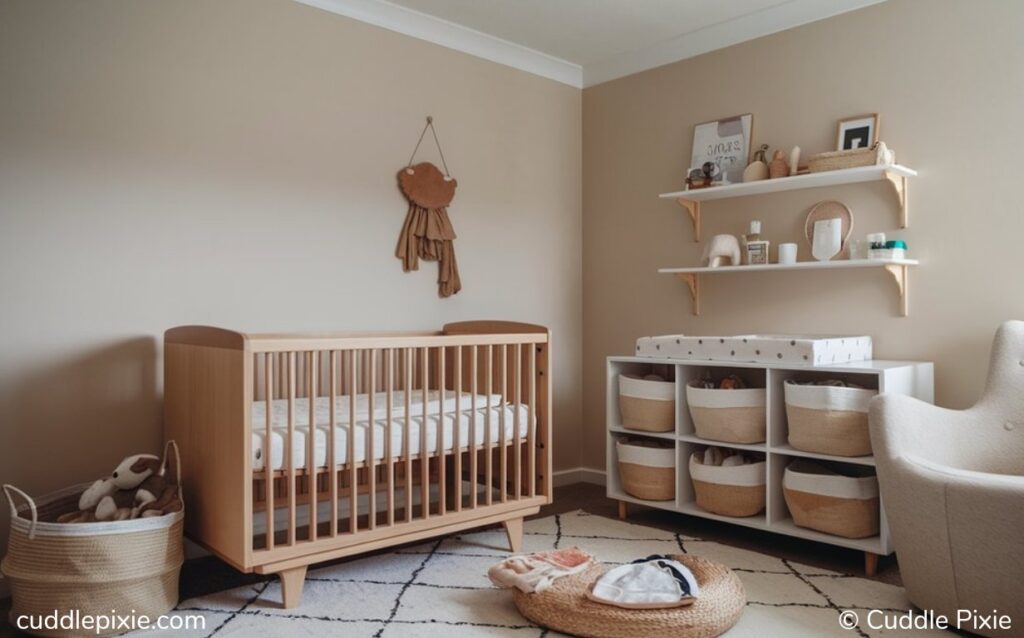
Common Mistakes to Avoid in a Minimalist Nursery
Creating a minimalist nursery may seem simple, but there are a few common mistakes to watch out for.
1. Overloading the Room
One of the most important aspects of minimalist design is restraint. It can be tempting to fill the room with cute baby décor, but try to resist the urge. Stick to the essentials and choose a few meaningful pieces that add warmth and personality without cluttering the space.
2. Ignoring Practicality for Aesthetics
While aesthetics are important, it’s crucial to remember that a nursery needs to be functional above all else. Make sure the furniture you choose is not only beautiful but also practical and safe for your baby.
3. Using Too Many Decorative Elements
Minimalist design is all about simplicity. Avoid using too many decorative elements like throw pillows, wall art, or rugs. Instead, focus on a few well-chosen pieces that make a statement without overwhelming the space.
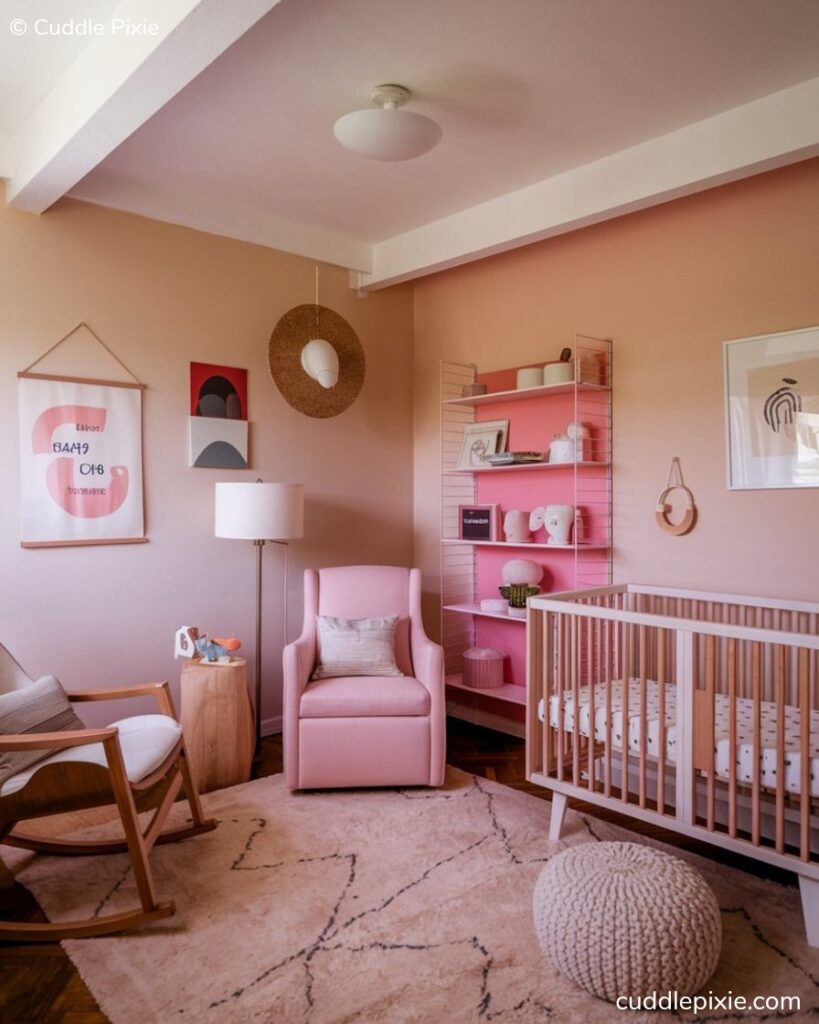
Best Minimalist Nursery Products
When it comes to designing a minimalist nursery, choosing the right products is key. Here are a few recommendations for high-quality, eco-friendly items that will fit perfectly in your minimalist nursery.
1. Babyletto Hudson Crib
This modern, eco-friendly crib is made from sustainable New Zealand pine wood and features non-toxic finishes. It’s a great choice for parents who want a stylish yet functional crib that can grow with their baby.
2. Pehr Organic Cotton Crib Sheets
Pehr’s crib sheets are made from 100% organic cotton and come in a range of soft, neutral colors. They’re GOTS-certified, ensuring they’re free from harmful chemicals and safe for your baby’s sensitive skin.
3. Lorena Canals Washable Rugs
These machine-washable rugs are made from natural cotton and come in simple, elegant designs that fit perfectly in a minimalist nursery. They’re also eco-friendly and free from toxic dyes.
Final Thoughts
Designing a minimalist nursery is about more than just creating a beautiful space. It’s about fostering a peaceful, calming environment for your baby while making thoughtful, sustainable choices. By focusing on simplicity, functionality, and eco-friendliness, you can create a nursery that not only looks great but also supports your baby’s well-being and growth.
Embrace the minimalist mindset, and remember that less is truly more. With the right design elements and a few carefully chosen products, you can create a nursery that’s both stylish and practical—one that will serve your family well for years to come.
